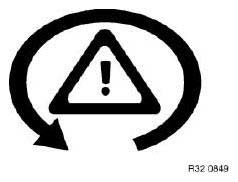BMW X5: Instructions On Starting Aid
Do not start the engine with help of starting sprays.
Preparation:
Conform with the following when starting engine with starting cable.
- Ensure that jump lead wires are to appropriate cross-section size.
- Only use fuse-protected jump leads.
- Check whether the current supplying battery has 12 V voltage.
- If engine is started from battery of another vehicle, ensure that there is no contact between the bodies of both vehicles.
CAUTION: Never touch ignition system components and current - dangerous high tension!
If the battery in the vehicle supplying power is weak, start the engine of this vehicle and let it run at idling speed.
Carrying out:
Always conform with the procedures to avoid injury to persons or damage to parts.
- On automatic transmission, select "P" setting, apply handbrake.
- Move the shift lever of vehicles with manual transmission into neutral and apply the parking brake.
- Ensure that the jump leads cannot get caught in rotating parts, e.g. fan.
- First connect positive terminals of both batteries with one jump lead (red).
- Use positive connection point in engine compartment for vehicles with one battery in trunk.
- Then attach second jump lead (black) to negative terminal of donor battery and to engine ground or body ground on vehicle to be started.
CAUTION: Never connect second jump lead (black) to negative terminal of battery in vehicle to be started. This would produce explosive gas which could be ignited by sparks.
Danger of explosion!
After engine of vehicle to be started has started up, first disconnect the jump lead on the negative terminal/ground connection. Then remove jump lead from positive terminals.
TEACHING IN CENTRE POSITION FOR POWER STEERING (ACTIVE FRONT STEERING) (FROM 03/2007)
NOTE: Carry out the following procedure after disconnecting the battery or disconnecting electrical plug connections on the steering column switch cluster.
Turn on ignition, start engine if necessary.
Turn steering wheel twice in both directions to full lock.
IMPORTANT: If the indicator lamp does not go out after the ignition is turned on again, an adjustment of the active front steering must be carried out.

Fig. 148: Identifying Ignition Lamp Indicator
BATTERY
Battery care and maintenance
In low-maintenance batteries, check the acid level at least once a year. If necessary, top up with distilled water up to the top marking.
The increasing number of electronic control units in the car reduces the self-discharging time of the battery (even in standby mode). To maintain the battery service life and to avoid exhaustive discharging, recharge laid-up vehicles every 6 weeks at the latest. The time for self-discharging depends on vehicle type and equipment specification.
Battery test
The battery acid density can be used to measure the charge state. However this test produces uncertainty caused by a design-related range of variation. The acid density e.g. for a charged battery is 1.28 kg/l (in the tropical version the acid density is 1.23 kg/l).
Another interference factor is the acid lamination immediately after filling with distilled water.
Battery wear with partially sulphated and/or heavily contaminated plates will also lead to incorrect acid density test results.

